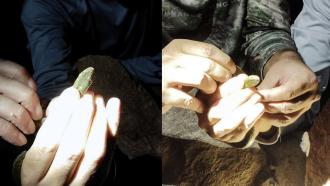![Saw-scaled viper, Mamallapuram, Tamil Nadu [Image Credits: Rupsy Khurana] With a variety in venoms, can one anti-venom be a panacea for all snakebites?](/sites/researchmatters/files/styles/large_800w_scale/public/panacea_for_all_snake_bites_result.jpg?itok=z1Ys4RXn)
Saw-scaled viper, Mamallapuram, Tamil Nadu [Image Credits: Rupsy Khurana]
Monsoon is the time of the year when herpetologists head out looking for snakes to study their ecology and behaviour. Unfortunately, it is also the time when many people fall victim to snake bites, which turn fatal sometimes. It is estimated that a whopping 1.2 million deaths occurred in India due to snakebites between 2001-2020. Though India has about 60 venomous species of snakes capable of delivering life-threatening bites, the ‘big four’ — cobras, kraits, Russell’s vipers and saw-scaled vipers — cause most of the deaths.
Our healthcare system currently has one anti-venom that is used as a panacea against all snake bites, irrespective of the snake that has caused the bite. Although this sounds convenient, studies have shown that the venom of the same species of snakes, found in different geographic locations, can be different.
“Variations in the venom of the same species stems from the specific diet and habitat of the snake. Species that have a large distribution and occupy a wide range of habitats have an equally wide spectrum of diet. However, this diet might vary in populations inhabiting different ecological regions,” says Dr Karthikeyan Vasudevan. He is a scientist at the Centre for Cellular and Molecular Biology - Laboratory for the Conservation of Endangered Species (LaCONES, CCMB), Hyderabad.
In a recent study, Karthikeyan and his colleagues have investigated the difference in venom composition of Saw-scaled vipers (Echis carinatus) from three different states in India. The study, published in the journal Toxicon:X, was funded by the Council of Scientific and Industrial Research (CSIR).
Snake venoms have evolved over millions of years for prey capture and defence. Toxins in the venom can be broadly categorized as neurotoxins, cardiotoxins, hemotoxins, cytotoxins and mycotoxins, based on which part of the body they affect. Viper venoms, which are hemotoxic, can cause pain and inflammation, prevent the blood from clotting and disrupt red blood cells at the bite site.
Antivenoms are made by injecting small amounts of snake venom into other animals such as sheep. The antibodies produced as a response to the venom are then processed to produce antivenom. Successful treatment of the snake bite depends on the ability of antivenom to neutralise the toxins. The anti-venom currently used for the treatment of all snake bites is majorly produced using venom from saw-scaled vipers sourced only from one region in Tamil Nadu.
In the current study, the researchers procured venoms from Saw-scale vipers found in Rajasthan, Tamil Nadu and Goa to see the differences in their composition. They used various biochemical techniques to identify the proteins in the venoms and grouped the venom components based on their molecular weight. They found that the toxins of these vipers from Goa and Tamil Nadu had more high molecular weight proteins than the venom from Rajasthan.
The researchers further used chromatography and spectroscopy to study the different components or ‘fractions’ belonging to various toxin families and their abundance in the venom samples. They found that many of the biomolecules belonged to three toxin families- snaclecs, snake venom metalloproteinase (svMP), and phospholipase A2. While these are predominant toxins in the Echis genus of snakes, they showed a significant difference in their proportions.
Snaclecs or Snake lectins derange the blood clotting response of the victim, resulting in the blood clotting in the blood vessels or uncontrolled internal bleeding. The study found high levels of these toxins in the venom of the vipers from Tamil Nadu and Goa, indicating aggravated symptoms of the bite in these areas. The venom from Rajasthan showed low levels of L-amino oxidases — enzymes that cause swelling, the formation of blood clots and cell destruction.
Such differences in the venom composition lead to varying symptoms and might complicate the treatment with the antivenom currently in place, argue the researchers. “A few clinical reports from different parts of the country indicate inefficiency and inconsistency of the current antivenom,” says Karthikeyan. “Our findings imply that the antibodies raised against saw-scaled viper venom from one location might not be sufficient to neutralise all toxins from a different location.”
The researchers propose the need for exploring the complete DNA and RNA make up of the venomous snakes to understand the variations in their venom composition. It would also help to develop better antivenoms. However, establishing the differences is the first step.
“It would be interesting in future to evaluate the repercussions of this variation on the effectiveness of the antivenom therapy,” remarks Dr Kartik Sunagar from IISc, who was not a part of this study but has extensively studied snake venoms in India.






